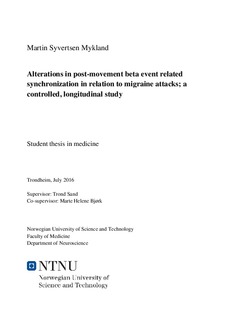| dc.contributor.advisor | Sand, Trond | |
| dc.contributor.author | Mykland, Martin Syvertsen | |
| dc.date.accessioned | 2016-11-07T09:36:35Z | |
| dc.date.available | 2016-11-07T09:36:35Z | |
| dc.date.issued | 2016 | |
| dc.identifier.uri | http://hdl.handle.net/11250/2419713 | |
| dc.description.abstract | Background: The migraine brain is believed to have altered excitability compared to controls and between migraine cycle phases. Our aim was to evaluate excitability through post-movement beta event related synchronization (PMBS) in sensorimotor cortices with and without sensory discrimination.
Subjects and methods: We recorded EEG of 41 migraine patients and 33 age and sex matched healthy controls on three different days with classification of days in relation to migraine pain attack phases (interictal, preictal < 36 h before attack, ictal and postictal <36 h after attack). During each recording, subjects performed one motor test with flexion and extension of the right wrist as well as a sensorimotor task (with a sensory assessment in addition to the motor task). Controls and migraine patients in the interictal phase were compared with repeated measures (R-) ANOVA and two sample Student’s t-test. Migraine phases were compared to the interictal phase with R-ANOVA and paired Student’s t-test.
Results: R-ANOVA results suggested that migraine patients had reduced difference between PMBS at contralateral (C3) and ipsilateral (C4) sensorimotor cortex in the preictal phase compared to the interictal phase and increased difference between PMBS at contralateral (C3) and ipsilateral (C4) sensorimotor cortex in the ictal phase compared to the interictal phase. Paired t-test showed that changes specifically occurred for ipsilateral right cortex (C4) after the sensorimotor task with significantly decreased PMBS ictally compared to the interictal phase and a tendency towards increased PMBS preictally compared to the interictal phase. No differences between migraine patients and controls were seen in the interictal phase.
Conclusion: The cyclic changes in PMBS for migraine patients may indicate that a dysfunction in sensorimotor cortex is involved in the migraine attack cascade. Current understanding of the PMBS phenomenon suggests that it is the level of cortical inhibition that is subject to cyclic modulation. This modulation, regulating the overall cortical excitability, may play a role in migraine attack initiation and continuation Elevated ipsilateral PMBS levels preictally and lowered ipsilateral PMBS ictally may consequently represent asymmetric cyclic changes, from somatosensory hypo- to hyperexcitability, as a result of alterations in basic cortical inhibitory mechanisms. | nb_NO |
| dc.language.iso | eng | nb_NO |
| dc.publisher | NTNU | nb_NO |
| dc.title | Alterations in post-movement beta event related synchronization in relation to migraine attacks : a controlled, longitudinal study | nb_NO |
| dc.type | Master thesis | nb_NO |
| dc.subject.nsi | VDP::Medical disciplines: 700 | nb_NO |
